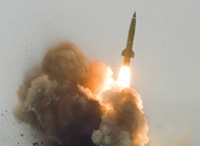Russia works on 100-ton monster ballistic missile
 In connection with the plans of the United States to develop the air defense system in Europe, in close vicinity to Russia's borders, and because of the unwillingness of the US side to provide any guarantees, the Russian Federation continues to take measures to preserve parity in the field. In particular, Russia's Strategic Missile Forces (SMF) will be renovated with the help of state-of-the-art Topol-M and Yars complexes during the upcoming ten years. In addition, Russia will pass into service a new intercontinental missile of enormous power.
In connection with the plans of the United States to develop the air defense system in Europe, in close vicinity to Russia's borders, and because of the unwillingness of the US side to provide any guarantees, the Russian Federation continues to take measures to preserve parity in the field. In particular, Russia's Strategic Missile Forces (SMF) will be renovated with the help of state-of-the-art Topol-M and Yars complexes during the upcoming ten years. In addition, Russia will pass into service a new intercontinental missile of enormous power.
"The decision about the creation of the new silo-based missile system with a liquid-fuel heavy missile has been made. The complex will have increased possibilities in overcoming the prospective missile defense system of the United States," Sergei Karakaev, the commander of the missile troops said.
The new missile, the mass of which is going to make up 100 tons, is said to replace the world-known "Voevoda" ICBM. In the West, this missile is known as "Satan." In the meantime, Russia has already started working to create the middle-class newly equipped missile. The new missile is to be passed into service in 2015, RIA Novosti reports.
"Russia does not stand against the US missile defense system. Russia stands against the creation of the missile defense system, which would be directly aimed against Russia to potentially reduce the possibilities of the Russian nuclear containment forces," the official stated.
According to Karakaev, as long as there is a stable mechanism of nuclear containment in the world, one should not undermine this mechanism to provoke an arms race.
In November, President Dmitry Medvedev announced a complex of measures, which Russia would use to respond to the deployment of the missile defense system in Europe. In particular, Medvedev did not rule out a possibility to refuse from the policy of disarmament. Russia could also revise the previous agreements about arms control, he added.
For the time being, there is no direct threat to Russia, the head of the missile troops stated. However, the Strategic Missile Forces will be prepared to respond fast, if necessary, the general added.
"Technically, there are no restrictions in the opportunity to apply the SMF missiles. It takes little time to pick an object of destruction and put this object into the flight assignment of an ICBM. For the time being, the combat groups of the SMF are on duty with a zero flight assignment, which means that the missiles are not targeted against anything," Interfax quoted the official as saying.
Russia's new Yars, Topol-M and Bulava ICBMs are unvulnerable to the US missile defense system. The commander of the Russian SFM said that it was best for the enemy to destroy the missile during the initial part of its flight, when it gathers speed. The missile separates later, which makes it harder for interceptors to detect the missile in a whole cloud of fake targets.
Russia's state-of-the-art ballistic missiles have the shortest boost phase of the flight - this phase is much shorter than it was with older missiles. "At this short part of the flight the missiles perform active maneuvers, which makes it impossible for interceptors to plan the attack.
"We conducted the tests to evaluate and confirm the nuclear safety of Topol warheads. The results of the tests showed that even in case of most complicated breakdowns, fires or explosions, the nuclear explosion of the warhead is excluded," Karakaev said.
Russia's present-day SMF consist of more than 350 missile complexes of six types. Three of them are silo-based and three others are mobile ground-based complexes. It is worthy of note that the Russian system of nuclear containment forces consists of the Strategic Missile Forces, strategic nuclear submarines and strategic bombers.
By the beginning of 2012, there will be 86 launch systems with Topol-M and Yars systems in the structure of the combat group of the SMF. The share of state-of-the-art arms in the SMF will thus grow up to 25 percent.
In 2012, Russia will begin the process to pass Yars missile complexes into service. The range of the system is up to 11,000 kilometers. It has a separating warhead with maneuverable and individually guided blocks. The system is highly maneuverable. In 2012, Russia will also complete the introduction of Topol-M missiles, the operational resource of which makes up not less than 20 years.
The life of operating missile complexes with RS-20B Voevoda, RS-18 Stilet and RS-12M Topol mobile missile complex will be prolonged. These systems still make the base of the Strategic Missile Forces.
However, it is expected that Stilet missiles will be put out of exploitation in 2017, whereas the time of Topol missiles will end in 2019. Voevoda missiles will stay on duty during the entire decade, at the time when the missile forces are being rearmed.
For the time being, as much as 70 percent of missile complexes are beyond their warranties. However, the required parameters of their reliability and technical readiness are still preserved. Not less than 96 percent of all of Russia's missile complexes are ready for immediate action every day.
"The share of new missile complexes in the SMF will constantly grow. By 2016, the share of new systems is to make up 60 percent. By 2021, this number is expected to grow to 98 percent, Karakaev said.
Subscribe to Pravda.Ru Telegram channel, Facebook, RSS!




